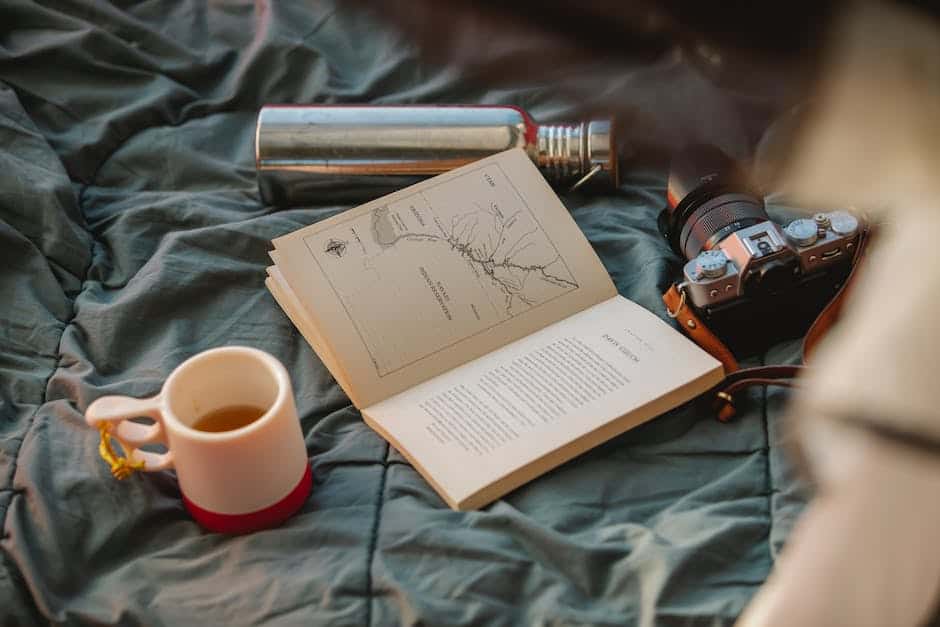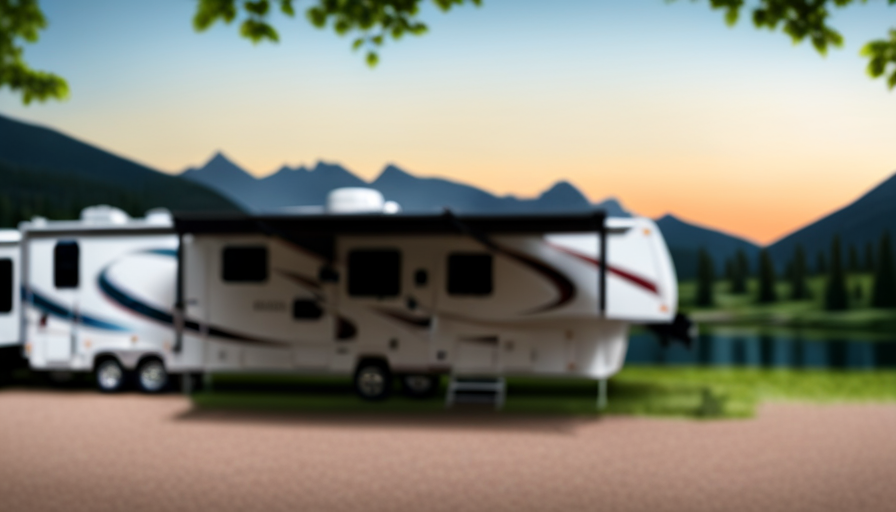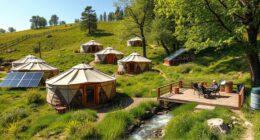You might be wondering, “Why should I think about investing in a Leer camper shell? Aren’t they just expensive and unnecessary additions for my truck?” However, it’s important to note that Leer camper shells are more than just an accessory; they truly enhance the experience for outdoor and adventure enthusiasts.
Now, before you dismiss the idea, let’s explore the facts. Leer camper shells come in various types, each catering to different needs and preferences. From basic, no-frills shells to high-end, feature-packed options, Leer has something for everyone.
But let’s get to the burning question on your mind: How much do Leer camper shells cost?
The price of a Leer camper shell depends on several factors. Size and compatibility with your truck, material and construction quality, additional features and accessories, and warranty and after-sales support all play a role in determining the price.
In this article, we will delve into all these aspects, providing an objective analysis of Leer camper shells. So, whether you’re a seasoned camper or a weekend warrior, read on to find the perfect Leer camper shell for your budget.
Key Takeaways
- Leer camper shells have a wide range of customizable options for different truck models and sizes, with prices depending on size, compatibility, material quality, additional features, and warranty.
- The average price range for Leer camper shells is $1,000 to $3,000, with basic models starting at $1,000 and premium models costing $2,500 to $3,000.
- Purchasing options for Leer camper shells include the Leer official website, local auto parts stores, online retailers, authorized dealerships, and secondhand marketplaces for pre-owned shells.
- Important considerations when purchasing Leer camper shells include compatibility with the vehicle, color choice, material and construction quality, and design features and functionality. Professional installation is recommended, and Leer provides a limited lifetime warranty and after-sales support.
Types of Leer Camper Shells Available
If you’re looking for a Leer camper shell, you’ll be pleased to know that there are a variety of types available to suit your specific needs. Leer offers a wide range of camper shells that can be customized to fit different truck models and sizes.
From the classic fiberglass construction to the more modern aluminum options, Leer provides options for every preference.
One popular type of Leer camper shell is the 100XQ. It boasts a sleek design that seamlessly blends with your truck’s body, giving it a factory-installed look. The 100XQ also offers customizable features such as keyless remote entry and interior LED lighting.
Another option is the 180XL, which provides extra height for increased cargo space. It’s a great choice for those who need to transport taller items.
When comparing Leer camper shells to other brands, the quality and durability stand out. Leer shells are known for their excellent craftsmanship and attention to detail. They are built to withstand various weather conditions and provide reliable protection for your cargo.
Factors that influence the price of Leer camper shells include the size, material, and additional features. Larger shells with more customization options tend to be more expensive. However, it’s important to consider the long-term benefits and value that a Leer camper shell can provide.
Factors that Influence the Price of Leer Camper Shells
One of the key factors that affect the price of these versatile accessories is the specific features they offer. When comparing Leer camper shell models, there are several factors to consider that can influence the price. Here are three important factors affecting Leer camper shell prices:
-
Size and Compatibility: The size of your truck bed plays a significant role in determining the price of a Leer camper shell. Larger truck beds require more materials and labor to manufacture and install the shell, resulting in a higher cost. Additionally, the compatibility of the shell with your specific truck model can also affect the price.
-
Material Quality: The type and quality of materials used in the construction of Leer camper shells can impact their price. Shells made from high-quality, durable materials such as fiberglass or aluminum tend to be more expensive than those made from cheaper materials.
-
Additional Features: Leer camper shells come with a variety of optional features, such as windows, roof racks, interior lighting, and ventilation. The inclusion of these features can increase the price of the shell. It’s important to consider which features are essential for your needs and budget.
Considering these factors when comparing Leer camper shell models can help you make an informed decision.
Next, we will delve into the topic of size and compatibility to further explore the factors that influence Leer camper shell prices.
Size and Compatibility
The size of your truck bed and its compatibility with the camper shell can significantly impact the price, as larger truck beds require more materials and labor. This is similar to how a bigger canvas requires more paint and time to complete a masterpiece.
When it comes to camper shell size, it’s important to consider the dimensions of your truck bed, including length, width, and height. Different truck models have varying bed sizes, so it’s essential to choose a leer camper shell that is specifically designed to fit your vehicle. A properly fitting camper shell not only enhances the aesthetic appeal of your truck but also ensures proper functionality and performance.
It provides a secure storage space for your belongings, protects them from the elements, and can even improve fuel efficiency by reducing wind resistance. However, choosing a camper shell that is too small or too large for your truck bed can lead to problems such as poor fit, decreased functionality, and potential damage. Therefore, it’s crucial to consult your vehicle’s specifications or consult with a professional to determine the right size and compatibility for your truck bed.
Moving on to the next section about material and construction…
Material and Construction
To ensure durability and longevity, you’ll want to consider the quality of materials and construction when selecting a camper shell for your truck bed. When it comes to leer camper shells, they offer a range of options that are built to withstand the elements and provide reliable protection for your belongings. Here are three key factors to consider:
-
Material: Leer camper shells are typically constructed from high-quality fiberglass or aluminum. Fiberglass shells are lightweight, resistant to dents, and offer excellent insulation. On the other hand, aluminum shells are strong, durable, and often more affordable. The choice between the two depends on your specific needs and budget.
-
Construction: Leer camper shells are designed with precision and attention to detail. They feature reinforced corners, secure locking mechanisms, and weatherproof seals to prevent leaks. The construction techniques ensure a tight fit on your truck bed, minimizing wind resistance and maximizing fuel efficiency.
-
Durability: Leer camper shells are built to last. The materials used and the construction methods employed contribute to their overall durability. They are resistant to fading, cracking, and warping, ensuring they maintain their appearance and functionality over time.
When considering the cost comparison and durability factors, it’s important to weigh the benefits of each option. Now, let’s explore the additional features and accessories available for leer camper shells.
Additional Features and Accessories
Imagine transforming your truck bed into a sanctuary with a plethora of customizable options and accessories, elevating your camping experience to new heights. When it comes to Leer camper shells, customization is key. Not only do they provide protection for your belongings, but they also offer a wide range of additional features and accessories to enhance your camping adventures.
Leer camper shells are designed to be versatile and cater to individual needs. Whether you’re looking for extra storage space, improved organization, or added convenience, Leer offers a variety of options to choose from. From roof racks and interior lighting to sliding windows and ventilation systems, there are countless ways to personalize your camper shell.
To help you visualize the possibilities, here is a table outlining some popular accessories for Leer camper shells:
| Accessory | Description |
|---|---|
| Roof rack | Provides additional storage space for outdoor gear |
| Interior lighting | Illuminates the interior of the camper shell, making it easier to find items |
| Sliding windows | Allows for increased airflow and easy access to the truck bed |
| Ventilation system | Helps regulate temperature and reduce condensation inside the camper shell |
| Bed liner | Protects the truck bed from scratches and dents |
With Leer camper shell customization, you have the freedom to create a camping setup that suits your specific needs and preferences. Now that you have an idea of the additional features and accessories Leer offers, let’s dive into the next section and explore the average price range for Leer camper shells.
Average Price Range for Leer Camper Shells
Now that we’ve discussed the additional features and accessories that can enhance the functionality and convenience of Leer camper shells, let’s dive into the average price range for these versatile truck bed covers.
When it comes to Leer camper shells, the price can vary depending on several factors such as the size, model, and specific features you choose. On average, you can expect to pay anywhere from $1,000 to $3,000 for a Leer camper shell.
-
Basic models: Starting at around $1,000, these Leer camper shells offer a simple design without many additional features. They provide excellent protection for your truck bed and are a budget-friendly option for those looking for a reliable cover.
-
Mid-range models: Falling in the $1,500 to $2,000 range, these Leer camper shells often include extra features such as sliding windows, interior lighting, and improved security features. They strike a balance between affordability and functionality.
-
Premium models: If you’re looking for top-of-the-line Leer camper shells, expect to spend around $2,500 to $3,000. These models come with advanced features like remote-controlled locking systems, integrated roof racks, and custom paint matching.
Using a Leer camper shell offers several benefits, including increased storage capacity, protection from the elements, and improved fuel efficiency. Whether you’re an outdoor enthusiast, a contractor, or simply someone who wants to make the most out of their truck, a Leer camper shell can be a valuable investment.
Now, let’s explore some budget-friendly options for Leer camper shells.
Budget-Friendly Options for Leer Camper Shells
Affordable options for Leer camper shells won’t break the bank while still providing reliable protection and added functionality for your truck bed. When looking for budget-friendly options, it’s important to consider the best features that meet your needs. Here are some options to consider:
| Option | Features | Price Range |
|---|---|---|
| Leer 100XR | Fiberglass construction, side access windows, customizable options | $1,200 – $1,800 |
| Leer 180XL | Full walk-in rear door, interior headliner, roof rack system | $1,800 – $2,400 |
| Leer 122 | Rear flip-up door, reinforced roof, optional side toolboxes | $1,500 – $2,000 |
| Leer 100RCC | Cab-high design, frameless curved glass rear door, keyless entry | $1,000 – $1,500 |
These budget-friendly options from Leer offer a range of features to suit different needs and budgets. Whether you need extra storage space, increased security, or a more aerodynamic design, there is a Leer camper shell that can meet your requirements.
Now that you know about the budget-friendly options available, let’s explore where to buy Leer camper shells and find the best deals.
Where to Buy Leer Camper Shells
Looking to find the perfect addition for your truck bed? Discover the best places to purchase high-quality Leer camper shells. Here are three top options to consider:
-
Leer Official Website: The official Leer website is a great place to start your search. They offer a wide range of camper shell models, each designed to fit specific truck makes and models. You can browse through their selection, compare features, and find the perfect shell for your needs. The website also provides detailed specifications and helpful information about each model.
-
Local Auto Parts Stores: Many local auto parts stores carry Leer camper shells. These stores often have knowledgeable staff who can help you find the right shell for your truck. Plus, you can see the shells in person and ask any questions you may have. Keep in mind that not all stores will have a wide selection, so it’s worth calling ahead to check their inventory.
-
Online Retailers: Online retailers such as Amazon and eBay also offer a variety of Leer camper shells. These platforms allow you to compare prices, read customer reviews, and have the shell delivered directly to your doorstep. Just be sure to verify the seller’s credibility and check if they’re an authorized dealer.
Using a Leer camper shell has many benefits, including increased security, weather protection, and additional storage space. It’s a practical investment for truck owners who frequently transport cargo.
In the next section, we’ll explore authorized dealerships where you can purchase Leer camper shells.
Authorized Dealerships
Ready to find the perfect place to purchase your new truck bed addition? Well, buckle up because I’m about to reveal the authorized dealerships where you can get your hands on top-quality Leer camper shells.
When it comes to authorized dealership locations, Leer has an extensive network of dealers across the country. You can easily find a dealership near you by visiting their official website and using their dealer locator tool. This allows you to conveniently find the nearest dealership and explore their inventory of Leer camper shells.
One of the major advantages of purchasing from an authorized dealership is the warranty coverage and terms offered. Leer stands behind their products with a comprehensive warranty that provides peace of mind to customers. The warranty coverage typically includes protection against manufacturing defects and materials. The specific terms may vary, so it’s important to review the warranty information provided by the dealership to understand what is covered and for how long.
So, now that you know where to find authorized Leer dealerships and understand the warranty coverage, let’s move on to the next step. In the next section, we will explore online retailers that also offer Leer camper shells for those who prefer the convenience of shopping from the comfort of their own home.
Online Retailers
After exploring authorized dealerships, it’s time to dive into the world of online retailers when it comes to purchasing Leer camper shells. Online shopping has become increasingly popular in recent years, offering convenience and a wide range of options for consumers.
When searching for Leer camper shells online, it’s essential to take advantage of the wealth of information available at your fingertips. Online reviews from fellow customers can provide valuable insights into the quality and performance of different Leer camper shell models. Additionally, comparison shopping websites allow you to compare prices, features, and customer ratings across various online retailers, ensuring you get the best deal possible.
It’s important to note that when shopping online, it’s always a good idea to buy from reputable retailers with a solid track record of customer satisfaction. With the convenience and information available online, you can make a well-informed decision when purchasing a Leer camper shell.
Now, let’s explore another avenue for finding Leer camper shells: the secondhand marketplaces.
Secondhand Marketplaces
Exploring the secondhand marketplaces can provide you with a multitude of options for purchasing pre-owned Leer camper shells. When browsing these platforms, you’ll come across a wide range of pricing factors to consider. To give you a clearer idea, here are two sub-lists that will help paint a picture in your mind:
-
Condition:
- Well-maintained camper shells in excellent condition: These might be slightly pricier but offer the advantage of being in top shape.
- Used camper shells with minor wear and tear: These can be more affordable and still provide functionality, with only cosmetic imperfections.
-
Accessories and features:
- Basic Leer camper shells: These models come with standard features and minimal accessories, making them more budget-friendly.
- Upgraded Leer camper shells: Equipped with additional features like windows, storage compartments, or roof racks, these models tend to be priced higher due to their added convenience.
When shopping in the secondhand marketplaces, it’s important to thoroughly research each listing, compare prices, and consider your specific needs. This will ensure you find the best value for your money.
Now, let’s delve into the next section about tips for finding discounts and deals on Leer camper shells without compromising quality.
Tips for Finding Discounts and Deals on Leer Camper Shells
When it comes to finding discounts and deals on Leer camper shells, there are a few tips that can help you save some money. First, consider checking out secondhand marketplaces, as mentioned in the previous section. These platforms often have used Leer camper shells available at a lower price than buying new. Additionally, keep an eye out for sales and promotions from authorized Leer dealerships. They may offer discounts or special offers at certain times of the year.
To give you a clearer picture, here is a table comparing the average prices of Leer camper shells in different conditions:
| Condition | Average Price |
|---|---|
| New | $1,500 – $3,500 |
| Used (Good) | $800 – $1,500 |
| Used (Fair) | $500 – $800 |
| Used (Poor) | $200 – $500 |
Remember, these prices are just averages and can vary depending on the specific model and features. It’s important to do your research and compare prices from different sellers to ensure you’re getting the best deal.
If you’re looking to save even more, the best time to buy a Leer camper shell is typically during the off-season or when new models are released. During these times, dealerships may offer discounts to clear out inventory or make room for the latest models.
Now, let’s move on to the next section where we will discuss the considerations you should keep in mind when purchasing a Leer camper shell.
Considerations When Purchasing a Leer Camper Shell
Before you make your decision, take into account the various factors to consider when purchasing a Leer camper shell, like navigating through a dense forest with the ease of a well-trimmed sailboat cutting through calm waters. When choosing a Leer camper shell, there are a few key considerations to keep in mind.
-
Compatibility with different vehicles: One important factor to consider is whether the Leer camper shell you’re interested in is compatible with your specific vehicle. Not all shells are designed to fit every make and model, so it’s crucial to check for compatibility before making a purchase.
-
Factors to consider when choosing a color: Another aspect to think about is the color of the camper shell. While this may seem like a purely aesthetic choice, it’s important to select a color that complements your vehicle and personal style. Additionally, certain colors may be more prone to fading or show dirt more easily, so it’s worth considering these factors as well.
-
Material and construction: When evaluating a Leer camper shell, it’s essential to assess the materials used and the construction techniques employed. Look for durable materials that can withstand different weather conditions and consider the overall quality of the craftsmanship.
-
Design features and functionality: Lastly, consider the design features and functionality of the Leer camper shell. Look for features that enhance convenience and ease of use, such as easy access doors and secure locking mechanisms.
When choosing a Leer camper shell, compatibility with your vehicle is crucial for a proper fit and seamless integration.
Compatibility with Your Vehicle
When considering the purchase of a Leer camper shell, one important factor to take into account is the compatibility with your vehicle. It’s crucial to ensure that the specific model you choose is designed to fit your make and model of vehicle. This will ensure a proper and secure installation, as well as optimal functionality.
Leer offers a wide range of camper shell options that are designed to fit various vehicle types, including trucks and SUVs. They provide detailed specifications and compatibility information for each model on their website, making it easy to find the right match for your vehicle. Additionally, Leer offers a helpful tool called the ‘Fit My Truck’ feature, which allows you to enter your vehicle’s details and receive a list of compatible camper shells.
When it comes to the installation process, Leer shells are generally designed for easy installation. They come with detailed instructions and all the necessary hardware for a straightforward installation. However, if you’re not comfortable installing it yourself, it’s always recommended to seek professional installation to ensure proper fitment and avoid any potential damage to your vehicle.
In terms of warranty coverage, Leer offers a limited lifetime warranty on their camper shells, which provides peace of mind knowing that you’re covered against any manufacturing defects or issues. It’s important to familiarize yourself with the specific terms and conditions of the warranty to understand what is covered and for how long.
Transition: Now that we’ve discussed the compatibility and warranty coverage, let’s move on to the installation process and how it can be done smoothly.
Installation Process
To install your new Leer camper shell smoothly, all you need to do is follow the detailed instructions provided and use the included hardware for a secure and hassle-free installation. The installation process for Leer camper shells is relatively straightforward, but there are a few tips that can help ensure a successful installation.
Firstly, it’s important to carefully read and understand the installation instructions before you begin. This will give you a clear understanding of the steps involved and any specific requirements for your vehicle. Additionally, taking the time to gather all the necessary tools and materials beforehand will make the process much easier.
One common mistake during installation is not properly aligning the camper shell with the truck bed. It’s crucial to ensure that the shell is centered and sits flush with the bed rails. This will not only improve the overall appearance but also prevent any potential leaks or damage.
Another common mistake is overtightening the mounting hardware. It’s important to follow the recommended torque specifications provided by Leer to avoid damaging the shell or your vehicle. Additionally, regularly checking and tightening the mounting hardware after installation will help maintain a secure fit.
Installing a Leer camper shell is a relatively simple process as long as you carefully follow the instructions and avoid common installation mistakes. Once you’ve successfully installed your new camper shell, you can enjoy the added functionality and versatility it provides for your outdoor adventures.
Transition: Moving on to the next section, let’s explore the warranty and after-sales support offered by Leer for their camper shells.
Warranty and After-Sales Support
Leer provides warranty coverage and reliable after-sales support for their camper shell products, ensuring peace of mind and assistance throughout your ownership experience. Can you imagine having the confidence of warranty coverage and a dedicated support team to rely on for your outdoor adventures?
When purchasing a Leer camper shell, you can take advantage of their warranty, which offers protection against any manufacturing defects or faults. This warranty helps to safeguard your investment and provides assurance that Leer stands behind the quality of their products.
In the event that you encounter any issues with your camper shell, their after-sales support team is readily available to assist you. Whether you have questions about installation, maintenance, or troubleshooting, Leer’s knowledgeable staff is there to help.
Leer’s commitment to customer satisfaction extends beyond the initial purchase. They understand that owning a camper shell is a long-term investment, and they strive to provide ongoing support throughout the lifespan of the product. Their after-sales support team can offer guidance on maintenance and care to ensure that your camper shell remains in optimal condition for years to come.
With Leer’s warranty coverage and dedicated after-sales support, you can confidently embark on your outdoor adventures, knowing that assistance is just a phone call away.
Now, let’s move on to discussing the pros and cons of investing in a Leer camper shell.
Pros and Cons of Investing in a Leer Camper Shell
Imagine the freedom and versatility of transforming your truck into a cozy camping haven with a Leer camper shell, but before you make the investment, let’s weigh the pros and cons.
When it comes to the pros, Leer camper shells offer several advantages. Firstly, they provide additional storage space, allowing you to carry all your camping gear without cluttering the truck bed. Secondly, they offer protection from the elements, keeping your belongings safe and dry. Moreover, Leer camper shells provide a comfortable sleeping area, making your camping experience more enjoyable.
On the downside, there are a few cons to consider. The initial cost of a Leer camper shell can be quite high, especially if you opt for additional features. Additionally, the added weight of the shell may impact your truck’s fuel efficiency. Maintenance is also important, as regular cleaning and inspections are necessary to prevent damage and ensure longevity.
To maintain your Leer camper shell, it’s recommended to clean it regularly with mild soap and water, and avoid using harsh chemicals or abrasive materials. Checking for any leaks or cracks is also crucial, as addressing them promptly can prevent further damage.
Overall, investing in a Leer camper shell can enhance your camping experience, but it’s important to carefully consider the pros and cons before making a decision. In the next section, we’ll explore customer reviews and testimonials to provide a well-rounded analysis.
Customer Reviews and Testimonials
After discussing the pros and cons of investing in a Leer camper shell, it’s important to consider what actual customers have to say about the product. Customer reviews and testimonials provide valuable insights into the overall satisfaction, durability, and longevity of Leer camper shells.
-
Customer Satisfaction: Many customers express their satisfaction with Leer camper shells, praising their functionality and ease of use. They appreciate the extra storage space and protection it provides for their belongings during outdoor adventures.
-
Durability: Several reviewers highlight the durability of Leer camper shells, stating that they’re built to withstand harsh weather conditions and rough terrains. They mention that the shells have proven to be reliable and long-lasting over time.
-
Longevity: Numerous testimonials mention the longevity of Leer camper shells, with customers reporting that their shells have remained in excellent condition even after years of use. This demonstrates the high-quality materials and construction techniques employed by Leer.
Customer reviews and testimonials play a crucial role in determining the reliability and satisfaction level of Leer camper shells. The positive feedback regarding their functionality, durability, and longevity showcases the brand’s commitment to providing a top-notch product.
Now, let’s move on to the next section and find the perfect Leer camper shell for your budget.
Conclusion: Finding the Perfect Leer Camper Shell for Your Budget
In conclusion, you can easily find the ideal camper shell from Leer that suits your budget and offers the perfect blend of functionality and durability.
When it comes to finding the best Leer camper shell for your needs, it’s important to compare them with other brands to ensure you’re making the right choice. Leer camper shells are known for their high-quality construction and innovative design features. They’re made from durable materials that can withstand various weather conditions and provide reliable protection for your belongings.
Additionally, Leer camper shells offer a range of options and accessories to customize your shell to meet your specific requirements. Whether you need extra storage space, increased security, or enhanced aerodynamics, Leer has a camper shell that can meet your needs.
When comparing Leer camper shells with other brands, it’s important to consider factors such as price, features, and customer reviews. By doing thorough research and comparing different options, you can find the perfect Leer camper shell that fits your budget and provides the functionality you desire.
Frequently Asked Questions
Can I customize my Leer camper shell with additional features and accessories?
Yes, you can customize your Leer camper shell with a variety of additional features and accessories. Leer offers a range of customization options to suit your needs and preferences. Some popular accessories include roof racks, interior lighting, windows, and rear doors. These accessories can enhance the functionality and convenience of your camper shell. By adding these features, you can personalize your Leer camper shell to create a customized camping experience that meets your specific requirements.
Are there any budget-friendly options available for Leer camper shells?
When it comes to budget-friendly options for camper shells, there are affordable alternatives available for Leer camper shells. These options provide a cost-effective solution for those looking to enhance their camping experience without breaking the bank.
These budget-friendly options offer similar functionality and features as the more expensive models, allowing customers to enjoy the benefits of a Leer camper shell at a more affordable price point.
Where can I buy Leer camper shells? Are there authorized dealerships or online retailers?
When it comes to buying Leer camper shells, there are a variety of options available. You can choose to purchase from authorized dealerships or online retailers.
Authorized dealerships offer the advantage of having knowledgeable staff who can provide personalized assistance and guidance. On the other hand, online retailers often offer a wider selection and the convenience of shopping from home.
Ultimately, the decision will depend on your preferences and needs. Both options can provide a seamless buying experience for Leer camper shells.
Can I find Leer camper shells in the secondhand marketplace?
Finding used Leer camper shells can be a cost-effective option for those looking to save money. When searching the secondhand marketplace, it’s important to thoroughly inspect the shell for any damages or wear. Additionally, negotiating the price is a common practice when buying secondhand. Researching the average price range for similar used Leer shells can give you an idea of what to expect. Remember to consider factors like condition, age, and any additional features included in the negotiation process.
Are there any tips for finding discounts and deals on Leer camper shells?
When it comes to finding discounts and deals on Leer camper shells, there are a few tips that can help you get the best price.
First, keep an eye out for sales, promotions, and coupon codes offered by Leer or authorized dealers.
Additionally, don’t be afraid to negotiate with the seller to see if they can offer a lower price.
Lastly, consider exploring alternative options or waiting for seasonal discounts to maximize your savings.
Why Are Leer Camper Shells More Expensive Than Other Brands?
When it comes to truck camper shell prices, Leer stands out as a brand known for its higher cost. The reasons behind this price difference are manifold. Leer camper shells offer exceptional quality, durability, and functionality. The brand invests heavily in research and development, ensuring their products incorporate innovative features. Additionally, Leer enjoys a strong reputation, which contributes to its higher prices. Ultimately, customers who prioritize long-term value and performance see Leer camper shells as a worthwhile investment.
Conclusion
In conclusion, when it comes to finding the perfect Leer camper shell for your budget, it’s important to consider the types available and the factors that influence their price.
Size, compatibility, material, construction, additional features, and warranty are all important factors to consider.
While investing in a Leer camper shell can offer numerous benefits, it’s important to read customer reviews and testimonials to ensure you’re making the right choice.
Remember, "time is money" and investing in a high-quality Leer camper shell can save you valuable time and money in the long run.










